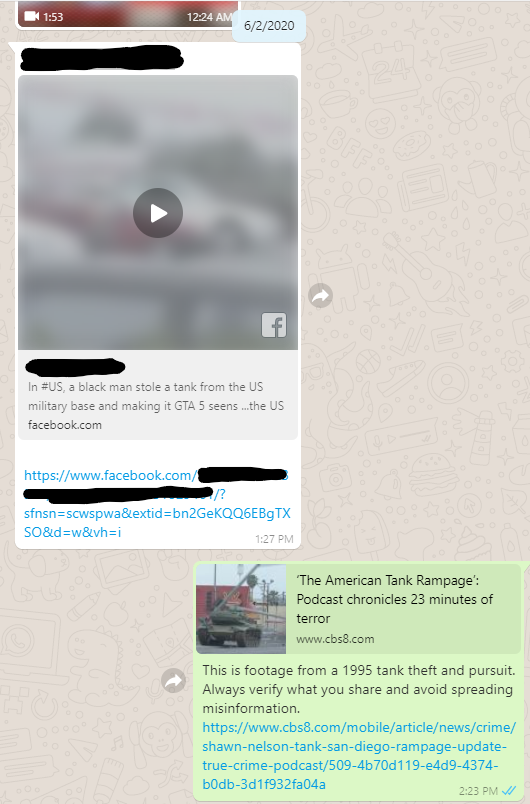I get annoyed when people on my social networks say “The news media doesn’t cover this story”. Here’s the rub; they either share a news story, or they never see the news that is published about the topic because of a filter bubble. Media watchers coined the term “fake news” to identify hoax stories and misinformation. Nowadays, people who don’t want themselves or their views to be criticized use the words “fake news” to attack credible news.
Distrust of credible reporting not only promotes division and extremism, but it also slowed the response to COVID-19. Due to distrust, many groups do not believe medical experts. As a result, they reject advice and orders that reduce the spread of the virus, such as wearing masks and limiting public outings. People who feel powerless resort to useless home remedies from bad sources and put themselves at risk, like when President Trump commented about injecting disinfectant (I’ll put a pin on this). Since most of us stay at home due to COVID-19, we need information to stay connected to the outside world.
Why Do People Distrust the News?
There are many reasons for distrust of credible news:
- Politicians, governments, and corporate figures can’t handle criticism or questions, and attack the messenger.
- Biased news sources and groups publish hoaxes and misinformation to spread fear and cultivate a loyal audience.
- Social networks run news feeds based on algorithms that predict a user’s engagement based on past actions. This is directly related to below:
- Clickbait: Posts that promote instinctual clicks on the link and engagement on social media through emotional titles or pictures. Sites also change headlines after the fact, either to correct the initial impression, update the story, or A/B test reactions.
- Traditional news sites supercharge clickbait by publishing fiery views in their opinion sections. This came up recently when journalists at The New York Times criticized the editors for publishing an opinion piece by Senator Tom Cotton that supported the use of military force against protests motivated by police violence against African-Americans (Is an elected official fanning the flames “all the news that’s fit to print”?)
- Newspaper revenues have dropped over the last decade due to free online news. This prevents the staffing of talented journalists and their ability to access sources for stories. If a tree falls in the forest and no one is around to hear it…
Developing a Healthy News Media Diet
I disagree with Joe Rogan on almost everything. But on his podcast The Joe Rogan Experience, he often points out the importance of a healthy “media diet”. Surrounding yourself with a quality news diet fosters an informed viewpoint and engagement with the world. Here are a few ways to develop a healthy news diet:
Become an active reader
The mark of a true skeptic is checking a story even when it matches what you already believe. If a story seems too good to be true, it probably is. Do you feel delighted or outraged by a story, and what does the story want you to do with your new feelings? Did you change your mind about something based on your reaction? Do you want to share it with others? Vote differently? Donate to a cause? Grab your pitchfork and join a mob?
Remember that pin I put on President Trump’s comments about injecting disinfectant. Can you believe that the President told Americans that injecting disinfectant might be a remedy? Outrageous!
Well, the truth was Trump was rambling about things he heard in a briefing. Granted, rambling to millions of Americans as President during a crisis is reckless. Also, later saying it was sarcasm to get a reaction from journalists means he lacks the integrity to stand by his word (important for a head of state and a supposed master negotiator). Yet, he didn’t say disinfectant was a remedy.
Learn to spot fake and satirical news. Do some digging if something doesn’t feel right. Look up the story on Snopes.com, Factcheck.org, or Politifact.com.
Many sites have credible-sounding names and professional design to make readers think they’re a professional news site. Biased sites mimic the names of reputable news to seem more credible Hint: If a site says they’re “real”, ” true”, “honest”, or “uncut”, they’re probably not. Publications should show their work, not just tell us they’re revealing the truth.
Some screenshots have a recognized site with an outrageous headline of a story that doesn’t exist. Viral posts juxtapose contradictory headlines without the byline, so people think that the site is flip-flopping when it’s just different authors. Always verify.
Subscribe to email newsletters
Prominent sites and blogs have free daily or headline email newsletters.
I recommend email newsletters over social media accounts and pages because it is the most direct channel between the news and you. You can use mail filters to direct emails to specific folders and keep your inbox tidy. If a source doesn’t give you what you need or you get too many emails, You can always unsubscribe.
By following news pages or accounts on social networks, their feeds will only provide stories the social network’s algorithm decides is interesting to you based on your likes and comments. Search engines determine what results you see based on whether pages will load quickly on a phone. or its content is optimized for keywords (if you came to this page from a search, Hi!) Relying on social media and search engines for news will trap you in a filter bubble.
Get a library card
Most public and college library cards grant access to online digital media, including audiobooks, ebooks, newspapers, magazines, and databases. If you’re enrolled in college or already graduated, you might have student and alumni access. I still keep older library cards when I move since library systems have different services.
Call out misinformation (but avoid arguing)
Our friends and relatives share stories that are more emotional than factual. People post videos from one event and say it’s about another event. A post or a viral image shared on Twitter and Facebook doesn’t back up its claim. A forward from Uncle Joe or Grandma has shocking claims or a big logical leap. The source might just make things up to promote their view.
Remember that pet peeve I mentioned at the start of this post?
To counter this, I either give context that is missing, link to a real story, or point out that the claim hasn’t been checked.

Sometimes facts aren’t enough to convince people. If this is the case, you may have to direct the conversation to an underlying motivation for sharing misinformation.
It’s tempting to respond to someone who replies with an attack on you or your reply. I try not to engage if it’s a stranger. That person may just want to waste your time and draw attention away from the facts. Only engage further if it’s someone whose well-being you care about.
Support real local news
Do you know who your mayor and council members are? When you vote, do you get dizzy from all the names and ballot questions after you made your choice for president or party? Does your city have a local news site?
Like I mentioned on #6 on the list above, Local news is struggling across the industry. Media companies are buying local news and making them vessels for advertisers and non-local stories. Recently, Sinclair Broadcasting was criticized for trying to air a story with a COVID-19 conspiracy theory to local stations. It’s easy to feel like you are a global citizen when you read news outside your neighborhood. But local news often affects you directly. Check out your local news and see if their stories are relevant to you.
Donate to non-profit journalism
Assume that any news site owned and funded by governments, or by media corporations funded by advertising, is influenced by their sponsors. Non-profit journalism is a possible answer to this. I donated to ProPublica for their story about the Red Cross after Hurricanes Sandy and Isaac. They also host databases that are easy to navigate.
What’s better, it’s much easier to look up the site’s IRS Form 990 and determine where the money you give them actually goes.
Support journalist and writer unions
To report the news, it’s important for journalists to be secure in their livelihood. Companies should give journalists the resources they need and stand by them during a crisis. Journalists are forming unions to protect their jobs and to make sure that media owners remember the role of journalism as a public good instead of a business.
Subscribe to news sites
Hear me out. We’re all annoyed by paywalls. When we try to read a story and get a popup that we reached the free article limit, we feel cheated that these news sites bait and switch us.
Unfortunately, news that looks free to us costs a lot to make. Paywalls and digital subscriptions are prominent revenue models for the news. They are a necessary evil.
If the story is important enough, and if the site is reliable enough, I bite the bullet and subscribe. I’m still careful about who I give my money to. For example, I refused to pay for The New York Times because of the decisions in their editorial section (#5 on the list above was a culmination of years of similar decisions)
Before you take your credit card from your wallet, is your library card there? See if your library lets you access digital subscriptions.
